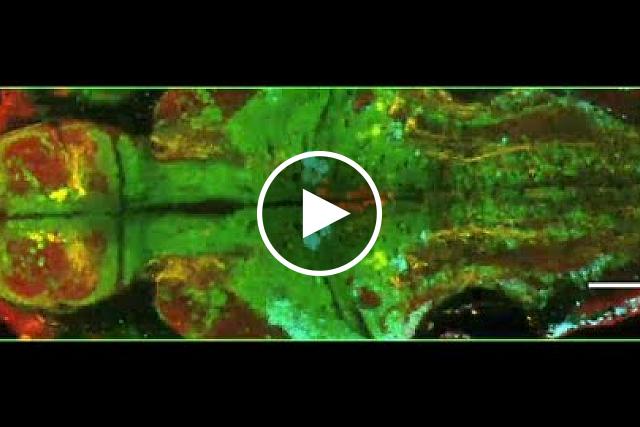
Institute/Center
Contact
301-443-4536
More Information
Brain’s alertness circuitry conserved through evolution
Molecular method reveals neuronal basis of brain states – NIH-funded animal study.
Using a molecular method likely to become widely adopted by the field, researchers supported by the National Institutes of Health have discovered brain circuitry essential for alertness, or vigilance – and for brain states more generally. Strikingly, the same cell types and circuits are engaged during alertness in zebra fish and mice, species whose evolutionary forebears parted ways hundreds of millions of years ago. This suggests that the human brain is likely similarly wired for this state critical to survival.
“Vigilance gone awry marks states such as mania and those seen in post-traumatic stress disorder and depression,” explained Joshua Gordon, M.D., Ph.D., director of the NIH’s National Institute of Mental Health (NIMH), which along with the National Institute on Drug Abuse, co-funded the study. “Gaining familiarity with the molecular players in a behavior – as this new tool promises – may someday lead to clinical interventions targeting dysfunctional brain states.”
Karl Deisseroth, M.D., Ph.D., Matthew Lovett-Barron, Ph.D., and Stanford University, Palo Alto, California, colleagues, report on findings using a neural activity screening technology they call Multi-MAP (Multiplexed-alignment of Molecular and Activity Phenotypes) online Nov. 2, 2017 in the journal Cell.
For the first time, Multi-MAP makes it possible to see which neurons are activated in a behaving animal during a particular brain state – and subsequently molecularly analyze just those neurons to identify the subtypes and circuits involved.
In this case, the researchers used the technique to screen activity of neurons visible through the transparent heads of genetically-engineered larval zebra fish. They gauged vigilance by measuring how long it took the animals to swish their tails in response to a threatening stimulus.
A molecular analysis revealing subtypes led to identification of six suspect circuits composed of distinct populations of neurons that modulate neuronal activity, only one of which had previously been linked to vigilance. Virtually the same players were operative in follow-up experiments examining such reaction time-related circuitry in mouse brain. Using optogenetics – another breakthrough exploratory tool developed by Deisseroth and colleagues -- the researchers narrowed the field to three circuits that definitively boost alertness in mice, including the one previously known. The other three are thought to play a reportorial rather than regulatory role.
Grants: MH099647, DA042012
About the National Institute of Mental Health (NIMH): The mission of the NIMH is to transform the understanding and treatment of mental illnesses through basic and clinical research, paving the way for prevention, recovery and cure. For more information, visit the NIMH website.
About the National Institute on Drug Abuse (NIDA): The National Institute on Drug Abuse (NIDA) is a component of the National Institutes of Health, U.S. Department of Health and Human Services. NIDA supports most of the world’s research on the health aspects of drug use and addiction. The Institute carries out a large variety of programs to inform policy, improve practice, and advance addiction science. Fact sheets on the health effects of drugs and information on NIDA research and other activities can be found at www.drugabuse.gov
About the National Institutes of Health (NIH): NIH, the nation's medical research agency, includes 27 Institutes and Centers and is a component of the U.S. Department of Health and Human Services. NIH is the primary federal agency conducting and supporting basic, clinical, and translational medical research, and is investigating the causes, treatments, and cures for both common and rare diseases. For more information about NIH and its programs, visit www.nih.gov.
NIH…Turning Discovery Into Health®
Reference
Lovett-Barron M, Andalman AS, Allen WE, Vesuna S, Kauvar I, Burns VM, Deisseroth K. Ancestral Circuits for the Coordinated Modulation of Brain State. 2017, Cell 171, 1–13 December 14, 2017 https://doi.org/10.1016/j.cell.2017.10.021


































No hay comentarios:
Publicar un comentario